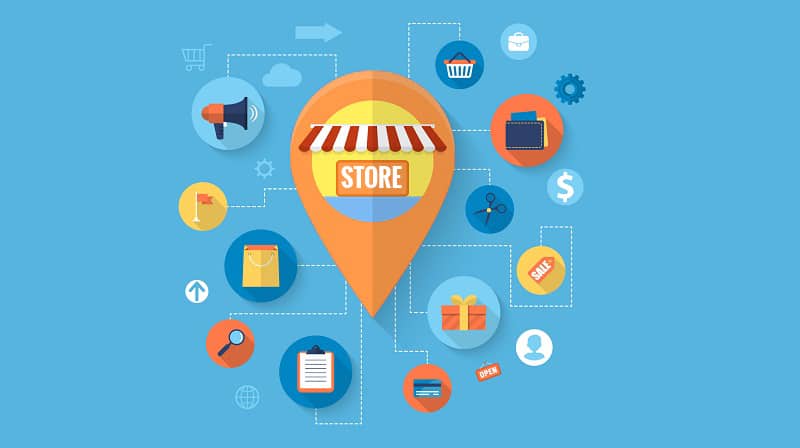Are you a location-based business owner struggling to attract customers in an increasingly competitive digital landscape? You’re not alone. With 80% of consumers wanting location-based alerts and 97% of people learning about local businesses online, mastering location-based marketing has become essential for survival—not just success.
This comprehensive guide will transform your understanding of local marketing and provide you with actionable strategies that drive real results. Whether you’re a restaurant owner, retail store manager, or service provider looking to start a business in challenging times, these proven techniques will help you dominate local search results and significantly increase foot traffic to your business.
What Is Location-Based Marketing and Why Does It Matter?
Location-based marketing is a strategic approach that leverages geographic data to deliver targeted messages to potential customers based on their physical location. Unlike traditional marketing methods, this approach allows businesses to reach consumers at the exact moment they’re most likely to make a purchase—when they’re nearby and actively searching for relevant products or services.
The Power of Proximity Marketing
Modern consumers expect immediate gratification and convenience. According to Google, 76% of people who search for something nearby on their smartphone visit a related business within a day, and 28% of those searches result in a purchase. Additionally, research from BrightLocal shows that 87% of consumers read online reviews for local businesses before making a decision. This presents an enormous opportunity for location-based businesses to capture high-intent customers.
Location-based marketing works by:
- Utilizing GPS technology and mobile device data
- Targeting users within specific geographic boundaries
- Delivering personalized messages based on user behavior and location
- Creating urgency through time-sensitive offers
- Building stronger community connections
Understanding Local Search Engine Optimization (SEO)
Before diving into specific strategies, it’s crucial to understand how search engines evaluate and rank location-based businesses. Google’s local search algorithm considers three primary factors:
1. Relevance
How well your business matches what someone is searching for. This includes your business information, categories, and how comprehensively you’ve completed your online profiles.
2. Distance
The proximity of your business to the searcher’s location or their specified search location. While you can’t control distance, you can optimize for location-specific keywords.
3. Prominence
How well-known your business is online and offline. This includes factors like reviews, ratings, citations, and overall online presence.
15 Proven Location-Based Marketing Strategies
1. Master Your Google Business Profile (Formerly Google My Business)
Your Google Business Profile is your digital storefront and often the first impression potential customers have of your business. Research shows that 87% of consumers read online reviews for local businesses, making your profile optimization critical. Furthermore, studies by local SEO experts indicate that Google Business Profile signals account for approximately 25% of local search ranking factors.
Essential Elements to Optimize:
- Business Name, Address, Phone (NAP): Ensure consistency across all platforms
- Business Categories: Select the most relevant primary category and appropriate secondary categories
- Business Hours: Include holiday hours and special event hours
- Website URL: Link to your business website for increased traffic
- Business Description: Craft a compelling 750-character description that includes relevant keywords naturally
- Photos: Upload high-quality images of your storefront, interior, products, and team
- Services/Products: List all offerings with detailed descriptions
- Attributes: Select all applicable attributes (wheelchair accessible, outdoor seating, etc.)
Pro Tips:
- Post regular updates about promotions, events, and news
- Respond to all reviews promptly and professionally
- Use Google Business Profile insights to understand customer behavior
- Enable messaging to allow direct customer communication
- Implement proven traffic generation strategies to drive more visitors to your profile
2. Implement Strategic Review Management
Online reviews significantly impact local search rankings and customer decision-making. Studies indicate that businesses with excellent reviews can increase revenue by 5-9%. Additionally, Harvard Business School research found that a one-star increase in Yelp rating leads to a 5-10% increase in revenue for restaurants.
Review Generation Strategies:
- Timing: Ask for reviews when customers are most satisfied (after successful service completion)
- Multiple Channels: Request reviews across Google, Yelp, Facebook, and industry-specific platforms
- Incentivization: Offer small incentives (discounts, loyalty points) for honest reviews
- Follow-up Systems: Implement automated email sequences to encourage customer reviews
- In-person Requests: Train staff to naturally ask satisfied customers for reviews
Review Response Best Practices:
- Respond to all reviews within 24-48 hours
- Thank customers for positive feedback
- Address negative reviews professionally and offer solutions
- Use keywords naturally in responses
- Encourage offline resolution for complex issues
3. Optimize Your Website for Local SEO
Your website serves as the foundation for all digital marketing efforts. Local SEO optimization ensures your site appears in location-based searches and provides value to local customers.
Technical Local SEO Elements:
- Local Schema Markup: Implement structured data to help search engines understand your business information according to Schema.org guidelines
- Location Pages: Create dedicated pages for each business location with unique content
- NAP Consistency: Ensure your name, address, and phone number match across all online mentions
- Local Keywords: Target location-specific keywords like “best pizza in [city]” or “[service] near me”
- Mobile Optimization: Ensure your site loads quickly and functions perfectly on mobile devices, as Google’s mobile-first indexing now prioritizes mobile versions
Content Strategy for Local SEO:
- Create location-specific blog content
- Develop city or neighborhood guide pages
- Share local event participation and community involvement
- Write about local industry trends and news
- Feature customer success stories from the area

4. Leverage Local Pay-Per-Click (PPC) Advertising
Location-based PPC campaigns can deliver immediate results and help new businesses compete with established competitors. Google Ads data shows that location-based searches have 50% higher conversion rates than non-location searches. According to WordStream research, local businesses typically see average click-through rates of 2-5% for search campaigns.
PPC Campaign Optimization:
- Geographic Targeting: Set precise location targeting to avoid wasting budget on irrelevant traffic
- Radius Targeting: Experiment with different radius sizes to find the optimal balance between reach and relevance
- Dayparting: Schedule ads to run during peak business hours and high-conversion times
- Ad Extensions: Use location extensions, call extensions, and sitelink extensions
- Negative Keywords: Exclude irrelevant terms to improve campaign efficiency
Budget Management:
- Start with a modest budget and scale based on performance
- Monitor cost-per-click (CPC) and cost-per-acquisition (CPA) metrics
- Adjust bids based on location performance data
- Use automated bidding strategies once you have sufficient data
5. Create Compelling Visual Content
Visual content plays a crucial role in attracting and converting local customers. High-quality images and videos can significantly impact customer perception and decision-making.
Essential Visual Content Types:
- Storefront Photos: Show your business exterior during different times of day
- Interior Shots: Highlight your space, atmosphere, and cleanliness
- Product Photography: Showcase your offerings with professional, appetizing images
- Team Photos: Introduce your staff to build trust and connection
- Behind-the-Scenes Content: Share your process, preparation, or manufacturing
- Customer Photos: Feature satisfied customers (with permission)
Video Content Ideas:
- Virtual tours of your business
- Product demonstrations or tutorials
- Customer testimonials and success stories
- Day-in-the-life content showing your team at work
- Local event coverage and community involvement
6. Develop a Multi-Platform Social Media Strategy
Social media platforms offer powerful tools for local business marketing, allowing you to engage with your community and attract new customers through targeted content and advertising.
Platform-Specific Strategies:
Facebook:
- Create and optimize your Facebook Business Page
- Join local community groups and participate authentically
- Use Facebook Events for promotions and special occasions
- Implement Facebook Ads with location targeting
- Share customer reviews and testimonials
Instagram:
- Use location tags and local hashtags
- Share behind-the-scenes content and product photos
- Partner with local influencers and micro-influencers
- Create location-specific Instagram Stories
- Use Instagram Shopping features for retail businesses
LinkedIn (for B2B businesses):
- Connect with local business professionals
- Share industry insights and expertise
- Participate in local business groups
- Sponsor local events and networking opportunities
7. Build Strategic Local Partnerships
Collaborating with complementary businesses and local organizations can expand your reach and create mutually beneficial relationships.
Partnership Opportunities:
- Cross-Promotion: Partner with non-competing businesses to promote each other’s services
- Local Events: Sponsor or participate in community events and festivals
- Charity Involvement: Support local causes and charities to build goodwill
- Business Associations: Join local chambers of commerce and business groups
- Supplier Relationships: Highlight local suppliers and vendors in your marketing
- Networking: Explore business networking opportunities to expand your professional connections
Partnership Benefits:
- Expanded customer base through referrals
- Shared marketing costs and resources
- Improved community reputation
- Access to new marketing channels
- Enhanced credibility through association
8. Implement Comprehensive Delivery and Pickup Solutions
Modern consumers increasingly expect convenience and flexibility in how they receive products and services. Implementing delivery and pickup options can significantly expand your customer base.
Delivery Service Options:
- Third-Party Platforms: Partner with DoorDash, UberEats, Grubhub, or similar services
- In-House Delivery: Develop your own delivery system for greater control
- Curbside Pickup: Offer convenient pickup options for customers
- Same-Day Delivery: Provide rapid fulfillment for urgent orders
- Subscription Services: Create recurring delivery programs for regular customers
Operational Considerations:
- Calculate delivery costs and pricing strategies
- Optimize delivery routes for efficiency
- Train staff on delivery best practices
- Implement tracking systems for customer transparency
- Maintain quality standards during transport
9. Harness the Power of Local Citations and Directory Listings
Local citations—mentions of your business name, address, and phone number—help search engines verify your business information and improve local search rankings.
Essential Directory Listings:
- Primary Directories: Google, Yelp, Apple Maps, Bing Places
- Industry-Specific Directories: TripAdvisor (restaurants), Angie’s List (services), Healthgrades (healthcare)
- Local Directories: City websites, chamber of commerce listings, local newspapers
- Niche Directories: Industry-specific platforms relevant to your business type
Citation Management Best Practices:
- Ensure NAP consistency across all platforms
- Regularly audit and update your listings
- Claim and optimize all relevant directory profiles
- Monitor for duplicate or incorrect listings
- Use citation management tools for efficiency
10. Create Location-Specific Content Marketing
Content marketing helps establish your expertise, improves SEO, and provides value to potential customers. Location-specific content can help you dominate local search results.
Content Ideas for Local Businesses:
- Local Event Coverage: Write about community events, festivals, and happenings
- Neighborhood Guides: Create comprehensive guides about your local area
- Local News Commentary: Share your perspective on local business news
- Customer Spotlights: Feature local customers and their stories
- Seasonal Content: Create content around local seasons, holidays, and traditions
- Local SEO Pages: Develop pages targeting “[service] in [city]” keywords
Content Distribution Strategy:
- Publish on your business website
- Share across social media platforms
- Include in email marketing campaigns
- Repurpose content for different formats (blog posts, videos, infographics)
- Submit to local publications and blogs
11. Optimize for Voice Search and Mobile
With the increasing popularity of voice assistants and mobile searches, optimizing for these technologies is crucial for local business success.
Voice Search Optimization:
- Natural Language Keywords: Target conversational phrases like “Where’s the best pizza near me?”
- Question-Based Content: Create content that answers common questions about your business
- Local Intent Keywords: Focus on “near me” and location-specific searches, which voice search statistics show account for 27% of mobile searches
- Featured Snippets: Optimize content to appear in position zero results
- FAQ Pages: Develop comprehensive FAQ sections using natural language
Mobile Optimization:
- Ensure fast loading times (under 3 seconds) as recommended by Google’s PageSpeed Insights
- Implement responsive design for all devices
- Use large, touchable buttons and clear navigation
- Optimize forms for mobile input
- Provide click-to-call functionality for easy contact
12. Leverage Email Marketing for Local Customers
Email marketing remains one of the most effective digital marketing channels, with an average ROI of $42 for every $1 spent according to DMA research.
Local Email Marketing Strategies:
- Location-Based Segmentation: Send targeted messages based on customer location
- Local Event Promotion: Announce special events, sales, and promotions
- Seasonal Campaigns: Create content around local seasons and holidays
- Customer Retention: Develop loyalty programs and repeat customer incentives using proven customer review strategies
- Abandoned Cart Recovery: Follow up with customers who showed interest but didn’t purchase
Email Campaign Types:
- Welcome series for new customers
- Weekly newsletters with local news and updates
- Special promotions and discounts
- Customer birthday and anniversary campaigns
- Product recommendations based on purchase history
13. Implement Geo-Fencing and Proximity Marketing
Geo-fencing technology allows you to create virtual boundaries around specific locations and send targeted messages to customers when they enter these areas.
Geo-Fencing Applications:
- Competitor Conquest: Target customers near competitor locations
- Event Marketing: Reach attendees at local events and conferences
- Retargeting: Re-engage customers who have visited your location
- Timing Optimization: Send messages during peak business hours
- Personalization: Customize messages based on customer behavior and preferences
Best Practices:
- Keep messages relevant and valuable
- Avoid overwhelming customers with too many notifications
- Test different message types and timing
- Monitor engagement metrics and adjust accordingly
- Respect customer privacy and preferences
14. Develop Strategic Influencer Partnerships
Influencer marketing can be particularly effective for local businesses when partnering with local influencers who have engaged audiences in your area.
Finding Local Influencers:
- Micro-Influencers: Partner with influencers who have 1,000-10,000 local followers
- Industry Relevance: Choose influencers whose audience matches your target customers
- Authentic Engagement: Prioritize influencers with genuine engagement over follower count
- Local Connection: Select influencers who are genuinely connected to your community
- Content Quality: Evaluate the quality and style of their content
Collaboration Ideas:
- Product reviews and demonstrations
- Behind-the-scenes content creation
- Event coverage and promotion
- Contests and giveaways
- Long-term brand ambassador programs
15. Track Performance and Optimize Continuously
Successful location-based marketing requires ongoing monitoring, analysis, and optimization. Regular performance tracking helps you understand what’s working and identify areas for improvement.
Key Performance Indicators (KPIs):
- Search Rankings: Monitor your position for target keywords
- Website Traffic: Track organic and paid traffic from local searches
- Conversion Rates: Measure how many visitors become customers
- Review Metrics: Monitor review count, rating, and response rates
- Social Engagement: Track likes, shares, comments, and mentions
- Revenue Attribution: Connect marketing efforts to actual sales
Analytics Tools:
- Google Analytics for website performance
- Google Search Console for search visibility
- Google Business Profile Insights for local search data
- Social media analytics for platform-specific metrics
- Customer relationship management (CRM) systems for sales tracking
- Google Tag Manager for advanced tracking implementation
Advanced Location-Based Marketing Techniques
Hyperlocal SEO Strategies
Take your local SEO beyond basic optimization with hyperlocal strategies that target specific neighborhoods, streets, or landmarks within your service area.
Hyperlocal Content Ideas:
- Create pages for specific neighborhoods you serve
- Write about local landmarks and attractions
- Develop location-specific landing pages
- Share neighborhood-specific tips and advice
- Cover local news and events in detail
Seasonal and Event-Based Marketing
Align your marketing efforts with local seasons, holidays, and events to maximize relevance and engagement.
Seasonal Marketing Tactics:
- Create holiday-specific promotions and content
- Develop seasonal product offerings
- Participate in local festivals and events
- Adjust operating hours for local preferences
- Leverage weather-based marketing opportunities
Community Engagement and PR
Build strong relationships with your local community through genuine engagement and public relations efforts.
Community Engagement Strategies:
- Sponsor local sports teams and events
- Participate in charity drives and fundraisers
- Host community events at your location
- Offer free services to local nonprofits
- Create educational workshops and seminars
Frequently Asked Questions About Location-Based Marketing
What is location-based marketing and how does it work?
Location-based marketing uses geographic data to deliver targeted advertising and promotional messages to consumers based on their physical location. It works by utilizing GPS technology, mobile device data, and location-based platforms to reach potential customers when they’re near your business or in your target area. This approach allows businesses to connect with high-intent consumers who are more likely to make immediate purchases.
How can I improve my local search rankings quickly?
To improve local search rankings quickly, focus on these immediate actions: complete and optimize your Google Business Profile with accurate information, photos, and regular updates; encourage satisfied customers to leave reviews and respond to all reviews promptly; ensure your NAP (name, address, phone number) is consistent across all online platforms; create location-specific content on your website; and build quality local citations on relevant directories. While some changes may take time to show results, these foundational steps can begin improving your visibility within weeks.
What’s the difference between local SEO and traditional SEO?
Local SEO focuses on optimizing your online presence for location-based searches, targeting customers in specific geographic areas who are looking for nearby businesses. Traditional SEO targets broader, non-location-specific keywords and aims to rank for general search terms. Local SEO emphasizes factors like Google Business Profile optimization, local citations, reviews, and location-specific content, while traditional SEO focuses more on general keyword optimization, backlink building, and broad content creation.
How much should I budget for location-based marketing?
Marketing budgets for location-based businesses typically range from 3-10% of gross revenue, depending on your industry, competition level, and growth goals. For new businesses, consider allocating 7-10% to establish market presence quickly. Distribute your budget across multiple channels: 30-40% for digital advertising (Google Ads, social media ads), 20-30% for website and SEO optimization, 15-20% for review management and local listings, and 15-20% for content creation and social media marketing. Start with a modest budget and scale based on performance data.
How do I measure the ROI of my location-based marketing efforts?
Measure ROI by tracking key performance indicators such as website traffic from local searches, phone calls and form submissions, foot traffic increases, conversion rates from online to offline purchases, and revenue attribution from different marketing channels. Use tools like Google Analytics, Google Business Profile Insights, call tracking software, and point-of-sale systems to gather data. Calculate ROI by dividing the additional revenue generated by marketing efforts by the total marketing investment, then multiply by 100 for a percentage.
Can location-based marketing work for service-based businesses without physical locations?
Yes, location-based marketing can be highly effective for service-based businesses. Focus on optimizing for your service areas rather than a specific address, create location-specific landing pages for each area you serve, target local keywords related to your services, participate in local online communities and directories, and encourage reviews from customers in different locations. Many service businesses successfully use location-based marketing to dominate local search results in multiple cities or regions.
How important are online reviews for local business success?
Online reviews are crucial for local business success, with research showing that 87% of consumers read online reviews for local businesses, and 94% say positive reviews make them more likely to use a business. Reviews impact both search rankings and customer decision-making. Nielsen studies indicate that 83% of consumers trust recommendations from people they know, while 66% trust online consumer opinions. Businesses with consistently positive reviews (4+ stars) typically see higher search visibility, increased click-through rates, and better conversion rates. Focus on providing excellent customer service and implementing systematic review generation strategies to maintain a strong online reputation.
Conclusion: Dominating Local Markets Through Strategic Marketing
Success in location-based marketing requires a comprehensive approach that combines multiple strategies, consistent execution, and continuous optimization. By implementing the techniques outlined in this guide, you’ll be well-equipped to dominate local search results, attract more customers, and build a thriving location-based business.
Remember that effective location-based marketing is not about implementing every strategy at once, but rather about choosing the right mix of tactics that align with your business goals, budget, and target audience. Start with the foundational elements—Google Business Profile optimization, review management, and local SEO—then gradually expand your efforts as you see results.
The digital landscape continues to evolve, with new technologies and platforms emerging regularly. Stay informed about industry trends, monitor your performance metrics, and be prepared to adapt your strategies as consumer behavior and technology change. Consider exploring innovative business ideas that can complement your location-based marketing efforts.
Most importantly, never lose sight of the fact that successful location-based marketing is ultimately about building genuine relationships with your local community. Focus on providing exceptional value, outstanding customer service, and authentic engagement, and your marketing efforts will naturally become more effective.
Ready to Transform Your Local Business?
Don’t let your competition dominate the local market while you struggle to attract customers. The strategies in this guide have helped thousands of location-based businesses increase their visibility, attract more customers, and significantly boost their revenue.
Take action today by starting with these three immediate steps:
- Optimize your Google Business Profile with complete information, high-quality photos, and regular updates
- Implement a systematic review generation strategy to build social proof and improve search rankings
- Create location-specific content that addresses your local customers’ needs and interests
For more comprehensive business growth solutions designed specifically for entrepreneurs and small business owners, visit BusinessAnywhere.io to learn about our expert services.
Your local market dominance starts with the first step—take it today.






